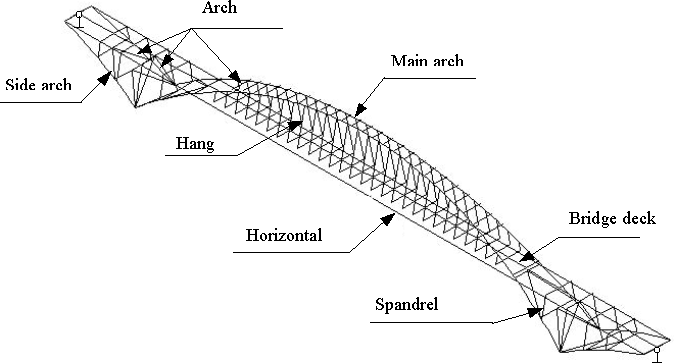
engineering & technology publications
ISSN 1759-3433
PROCEEDINGS OF THE SIXTH INTERNATIONAL CONFERENCE ON COMPUTATIONAL STRUCTURES TECHNOLOGY
Ultimate Load Carrying Capacity of Long-Span Steel Arch Bridges
+Department of Civil Engineering, University of Tsinghua, Beijing, P.R.China
*Department of Bridge Engineering, University of Tongji, Shanghai, P.R.China
The example bridge studied here is the Lupu Bridge, shown in Figure 94.1, which is the long-span welded steel half-through arch bridge under construction spanning the Huangpu River in Shanghai, China. It has a 550-m central span length, which will be the longest central span of any arch bridge in the world. The bridge span arrangements are (100+550+100) m. There are six traffic lanes. Rise-to-span ratio of the bridge is 1/5.5. Horizontal cables in the steel box girder are adopted to balance the horizontal force of the main arch rib. The tension of each horizontal cable is taken as 87900 KN, which is determined mainly by the horizontal force of the main arch rib. Complete structure data of the bridge can be obtained from [2].
In this paper, the three methods used in predicting the ultimate load carrying capacity of steel arch bridges are first reviewed. Using the Lupu Bridge as an example, ultimate load carrying capacity of the bridge is investigated using the three methods. Comparisons of the accuracy and reliability of the three methods are given. Attention is paid mainly to the following parameters, i.e., material nonlinear of individual bridge element, distribution pattern of live load, initial lateral deflection, yield stresses of material and changes of temperature. Their effects on the ultimate load-capacity of long-span steel arch bridges are examined.
- 1
- A.S. Vlahino, J.Ch. Ermpoulos and Yang-Cheng Wang, "Buckling Analysis of Steel Arch Bridges", Journal of Construction Steel Research, 26, 59-71,1993. doi:10.1016/0143-974X(93)90067-3
- 2
- Study on wind loads and wind-resistant stability of super-long-span arch bridges, Research Report, Tongji University, 2001.
purchase the full-text of this paper (price £20)
go to the previous paper
go to the next paper
return to the table of contents
return to the book description
purchase this book (price £125 +P&P)
